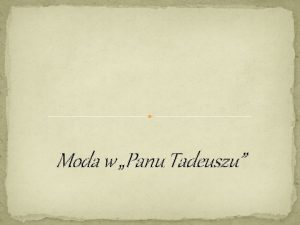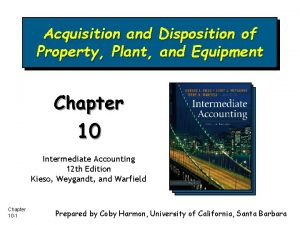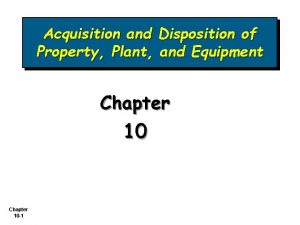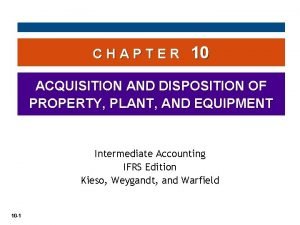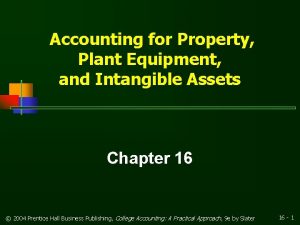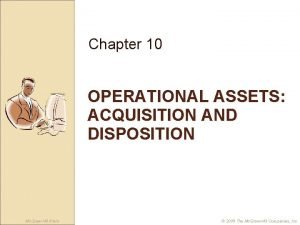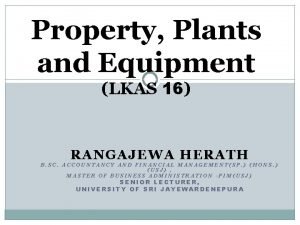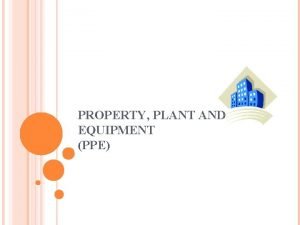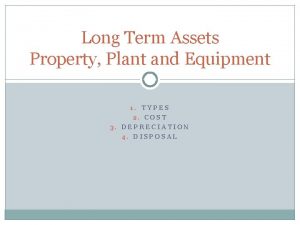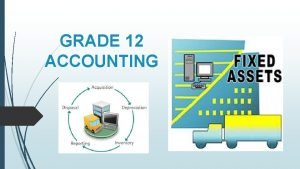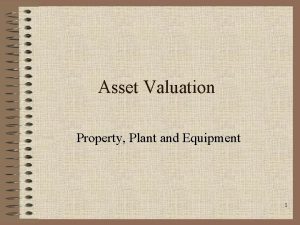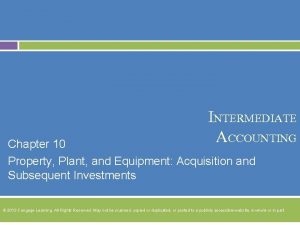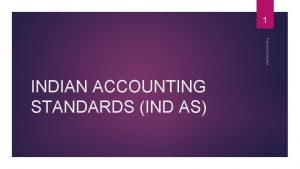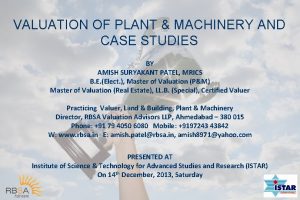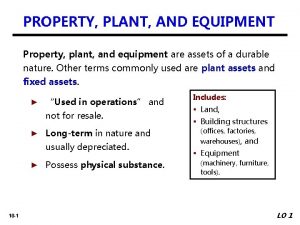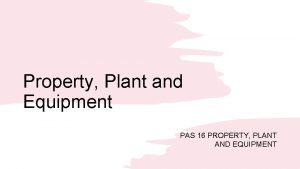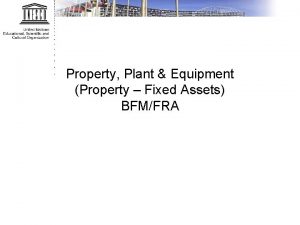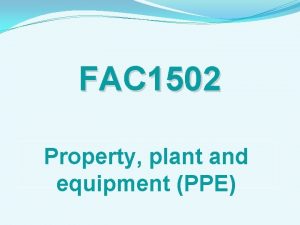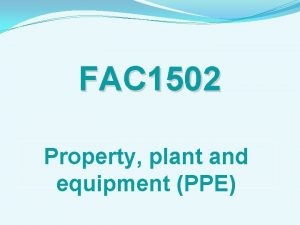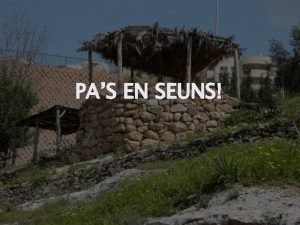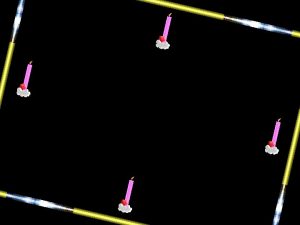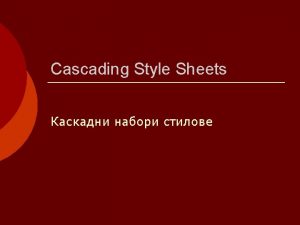Property Plant and Equipment PAS 16 PROPERTY PLANT


















- Slides: 18

Property, Plant and Equipment PAS 16 PROPERTY, PLANT AND EQUIPMENT

INITIAL RECOGNITION PAS 16 describes the accounting and disclosures for the property, plant and equipment necessary to provide users information about an entity's investment in its property, plant and equipment and the changes in them. The principal issues in accounting for PPE are the recognition of assets, the determination of their carrying amounts and the depreciation charges and impairment losses to be recognized in relation to them.

PROPERTY, PLANT AND EQUIPMENT ARE TANGIBLE ITEMS THAT ARE: 1. Held for use in the production or supply of goods or services, for rental to others, or for administrative purposes 2. Expected to be used during more than one period

CHARACTERISTICS OF PPE 1. Tangible assets 2. Used in normal operations 3. Long-term in nature

Examples of PPE 1. Land used in business 2. Land held for future plant site 3. Building used in business 4. Equipment used in the production of goods 5. Equipment held for environmental and safety reasons 6. Equipment rented out 7. Major spare parts and long-lived stand by equipment

Not examples of PPE 1. Land held for speculation 2. Land held for undetermined future site 3. Land or building rented out under operating lease 4. Land or building for sale in the ordinary course of business 5. Land or building held for sale under PFRS 5 6. Biological assets related to agricultural activity 7. Intangible assets 8. Minor spare parts and short-lived stand by equipment

RECOGNITION THE cost of an item of Property, Plant and Equipment shall be recognized as an asset only if: 1. it is probable that future economic beneits associated with the items will flow to the entity 2. the cost of the item can be measured reliably

SPARE PARTS AND SERVICING EQUIPMENT ITEMS suc as spare parts, stand by equipment and servicing equipment are recognized as PPE when they meet the definition of property, plant and equipment. For example MAJOR SPARE PARTS AND EQUIPMENT that are expected to be used for more than one period are recognized as PPE. OTHER Items are recognized as inventory.

SAFETY AND ENVIRONMENTAL EQUIPMENT Safety and environmental equipment, although not directly increasing the future economic benefits of any particular existing item of PPE, may be necessary for an entity to obtain the future economic benefits from its other assets. Non compliance with government regulations, non performance of contractual obligations, or simply failure to satisfy constructive obligations may negatively impact an entity's operations. Items of safety and environmental equipment are classified as PPE.

INITIAL MEASUREMENT Measured at COST Cost- is the amount of cash or cash equivalent paid or the fair value of the other consideration given to acquire an asset at the time of it acquisition or construction

ELEMENTS OF COST a. Purchase price, including import duties and non-refundable purchase taxes after deducting trade discounts and rebates. b. Any costs directly attributable to bringing the asset to the location and condition necessary for it to be capable of operating in the manner intended by the management. c. The initial estimate of the costs of dismantling and removing the item and restoring the site on which it is located, the obligation for which an entity incurs either when the item is acquired or as a consequence of having used the item during a particular period for purposes other than to produce inventories during that period. These costs are also called restoration costs or decommissioning costs. They are included in the PPE and depreciated accordingly. Provided a corresponding liablity is also recognized.

DIRECTLY ATTRIBUTABLE COSTS 1. Costs of employee benefits arising directly from the construction or acquisition of the item of PPE 2. Costs of site preparation 3. Initial delivery and handling costs 4. Installation and assembly costs 5. Costs of testing whether the asset is functioning properly, after deducting the net proceeds from selling any items produced while bringing the asset to the location and condition. 6. Professional fees

Costs charged to expense • The following costs should not be included in the cost of an item of PPE but rather charged as an expense when incurred: a. costs of opening a new facility b. costs of introducing a new product or service (including advertising costs and promotional activities) c. costs of conducting business in a new location or with a new class of customer (including costs of staff training) d. administration and other general overhead costs

CESSATION OF CAPITALIZING COSTS TO PPE Recognition of costs in the carrying amount of an item of PPE ceases when the item is in the location and condition necessary for it to be capable of operating in the manner intended by management. Therefore, costs incurred in using or redeploying are not included in the carrying amount of that item

The following costs are not included in the carrying amount of an item in the PPE 1. Costs incurred while an item capable of operating in the manner intended by management has yet to be brought into the use or is operating at less than full capacity 2. Initial operating losses such as those incurred while demand for the items output builds up 3. Costs of relocating or reorganizing part or all of an entity's operations

Income earned from incidental operations before an asset is put to use • Is recognized in profit or loss together with the related expenses during the period such incidental items arose. These incidental operations may occur before or during the construction or development activities. • For Example, income may be earned by temporary using a building site as a car park until construction starts. Incidental operations are not necessary in bringing the asset to the location and condition necessary for it to be capable of operating in the manner intended by the management. Thus, income and expenses incurred from such operations should be recognized in profit or loss immediately

Savings on self-constructed assets • Any internal profits (eg savings on self-construction) on selfconstructing items of PPE are eliminated or not recognized

Measurement of COST The cost of an item of PPE is the CASH PRICE EQUIVALENT at the recognition date. If payment is DEFERRED beyond normal credit terms, the difference between the cash price equivalent and the total payment is recognized as interest over the period of credit unless such interest is capitalized in accordance with PAS 23 Borrowing Costs.
 Moda staropolska
Moda staropolska Commercial substance
Commercial substance Acquisition and disposition of property plant and equipment
Acquisition and disposition of property plant and equipment Acquisition and disposition of property plant and equipment
Acquisition and disposition of property plant and equipment Property, plant, and equipment and intangible assets are
Property, plant, and equipment and intangible assets are Acquisition and disposition of property plant and equipment
Acquisition and disposition of property plant and equipment Slidetodoc.com
Slidetodoc.com Ppe structure
Ppe structure Plant assets are used in operations
Plant assets are used in operations Note 3 fixed assets
Note 3 fixed assets Fixed assets property plant equipment
Fixed assets property plant equipment Journal entry for revaluation of assets
Journal entry for revaluation of assets Chapter 10 property plant and equipment
Chapter 10 property plant and equipment Ind as 16 property plant and equipment
Ind as 16 property plant and equipment Texte lecture pas à pas
Texte lecture pas à pas Moteur pas à pas à aimant permanent
Moteur pas à pas à aimant permanent On ne peut pas ne pas communiquer
On ne peut pas ne pas communiquer Texte ne pleure pas devant ma tombe
Texte ne pleure pas devant ma tombe Valuation of plant and machinery
Valuation of plant and machinery
